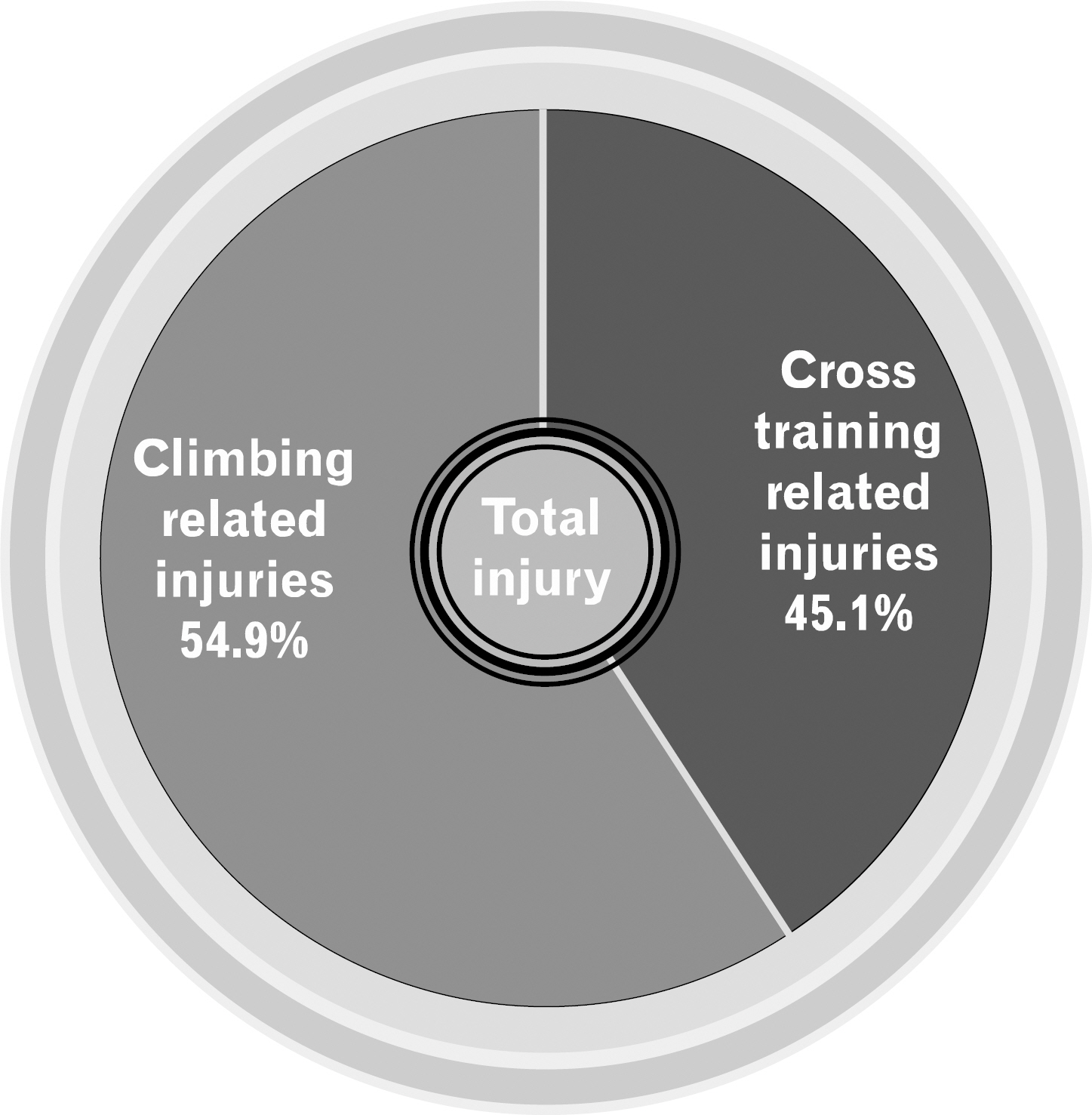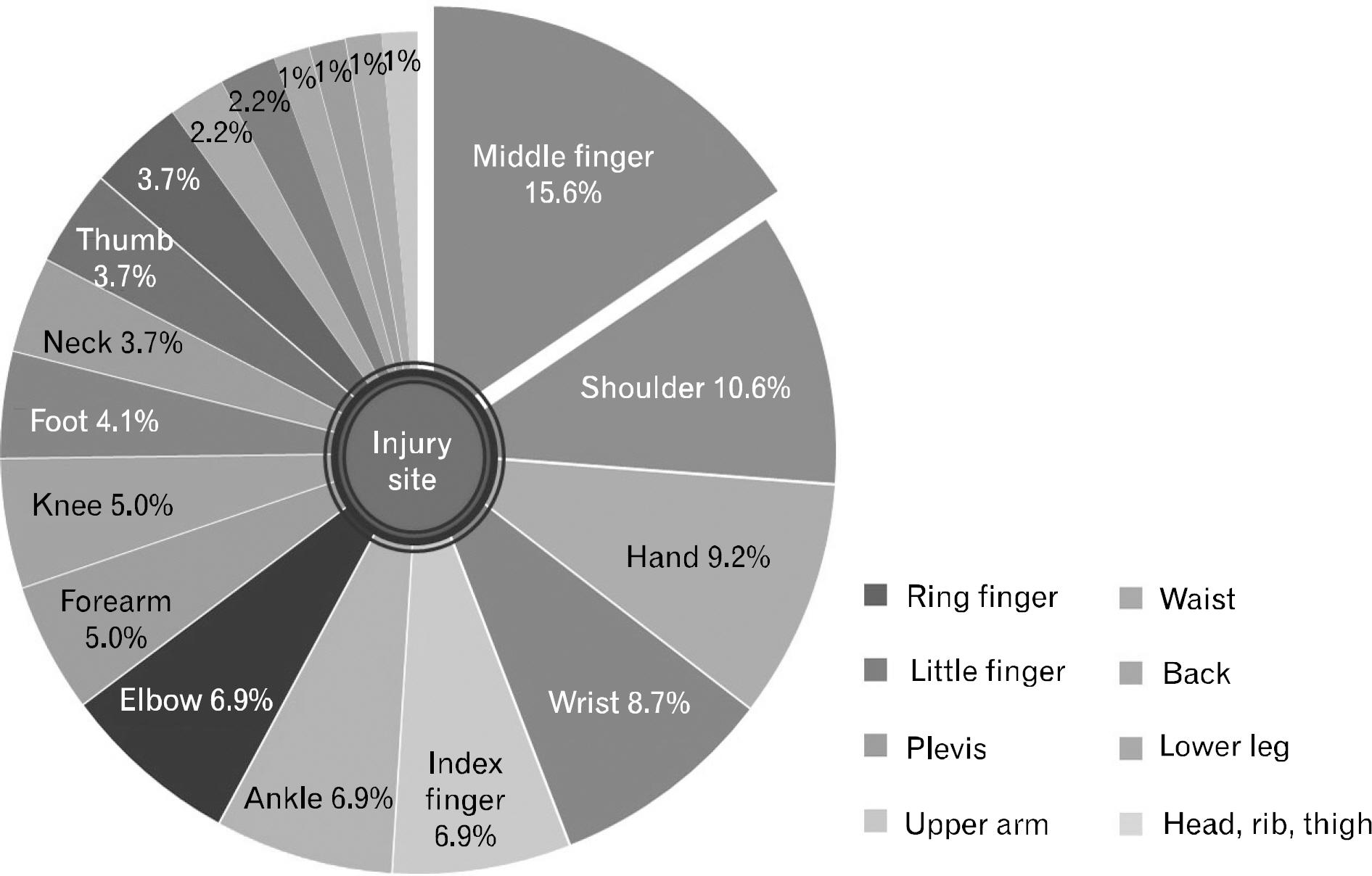Korean J Sports Med.
2014 Dec;32(2):85-91. 10.5763/kjsm.2014.32.2.85.
Risk Factors of Past Injuries among of the Sports Climbing Athletes Who Participated in the National Sports Festival
- Affiliations
-
- 1Department of Orthopaedic Surgery, Gyeongsang National University Hospital, Gyeongsang National University School of Medicine, Jinju, Korea. hbinpark@gnu.ac.kr
- KMID: 2288663
- DOI: http://doi.org/10.5763/kjsm.2014.32.2.85
Abstract
- The purpose of this study is to evaluate the risk factors regarding the injuries from sports climbing through an epidemiologic study. We performed a questionnaire survey on sports climbers who participated in the 93th Annual Sports Festival in Daegu, in October 2012. Sixty-nine climbers (male: 57, female: 12) responded to the survey. The t-test was used for comparisons of the incidence of injury, according to sex and career. The multiple linear regression analysis and the logistic regression analysis were used for the evaluation of risk factors that affected the occurrence of injury. Overall, 58 (84.06%) climbers had history of injury. The incidences of climbing related injuries were higher than the incidences of cross-training related injuries. However, there were no significant difference (p=0.680). Also, there was no significant difference between males and females (p=0.467), and professionals and amateurs (p=0.076). Fifty (72.46%) out of 69 climbers had history of traumatic injuries, and 40 (57.97%) climbers had history of overuse injuries. Significant risk factors for traumatic injuries are leading (odds ratio, OR=17.854), speed (OR=45.246), and bouldering (OR=13.595). Significant risk factors for overuse injuries are leading (OR=23.252) and bouldering (OR=41.260). Significant risk factors for middle phalanx injuries, which happens most frequently in climbing related injuries, are leading (OR=20.625) and bouldering (OR=25.756). For traumatic injuries, leading, speed, and bouldering are prone to cause injuries, and leading and bouldering are significant factors for overuse injuries. Therefore, it is considered that the systematic organized training can help reduce the incidence of injury.
Keyword
MeSH Terms
Figure
Reference
-
1. International Federation of Sport Climbing. Climbing compe-titions' history [Internet]. Torino (IT): International Federation of Sport Climbing;c2007. [cited 2013 Oct 31]. Available from:. http://www.ifsc-climbing.org/index.php/about-ifsc/what-is-the-ifsc/history.2. Shea KG, Shea OF, Meals RA. Manual demands and consequences of rock climbing. J Hand Surg Am. 1992; 17:200–5.
Article3. Rooks MD, Johnston RB 3rd, Ensor CD, McIntosh B, James S. Injury patterns in recreational rock climbers. Am J Sports Med. 1995; 23:683–5.
Article4. Holtzhausen LM, Noakes TD. Elbow, forearm, wrist, and hand injuries among sport rock climbers. Clin J Sport Med. 1996; 6:196–203.
Article5. Wright DM, Royle TJ, Marshall T. Indoor rock climbing: who gets injured? Br J Sports Med. 2001; 35:181–5.
Article6. Josephsen G, Shinneman S, Tamayo-Sarver J, et al. Injuries in bouldering: a prospective study. Wilderness Environ Med. 2007; 18:271–80.
Article7. Neuhof A, Hennig FF, Schoffl I, Schoffl V. Injury risk evaluation in sport climbing. Int J Sports Med. 2011; 32:794–800.
Article8. Schoffl V, Morrison A, Schwarz U, Schoffl I, Kupper T. Evaluation of injury and fatality risk in rock and ice climbing. Sports Med. 2010; 40:657–79.9. Schoffl V, Morrison A, Schoffl I, Kupper T. The epidemiology of injury in mountaineering, rock and ice climbing. Med Sport Sci. 2012; 58:17–43.10. Bowie WS, Hunt TK, Allen HA Jr. Rock-climbing injuries in Yosemite National Park. West J Med. 1988; 149:172–7.11. Limb D. Injuries on British climbing walls. Br J Sports Med. 1995; 29:168–70.
Article12. Schoffl V, Winkelmann HP. Accident statistics at "indoor climbing walls". Sportverletz Sportschaden. 1999; 13:14–6.13. Schoffl VR, Hoffmann G, Kupper T. Acute injury risk and severity in indoor climbing-a prospective analysis of 515,337 indoor climbing wall visits in 5 years. Wilderness Environ Med. 2013; 24:187–94.14. Paige TE, Fiore DC, Houston JD. Injury in traditional and sport rock climbing. Wilderness Environ Med. 1998; 9:2–7.
Article15. Jones G, Asghar A, Llewellyn DJ. The epidemiology of rock-climbing injuries. Br J Sports Med. 2008; 42:773–8.
Article
- Full Text Links
- Actions
-
Cited
- CITED
-
- Close
- Share
- Similar articles
-
- Risk Factors of Past Injuries among of the Rowing Athletes Who Participated in the National Sports Festival
- Low Back pain in Young Athletes: Epidemilogic Study of Risk Factors
- Longitudinal Panel Study of Sports Injuries in University Elite Athletes
- The survey on oral health and maxillofacial trauma incidence of the sports players in Korea
- Common Sports Injuries among National Players in Korea



